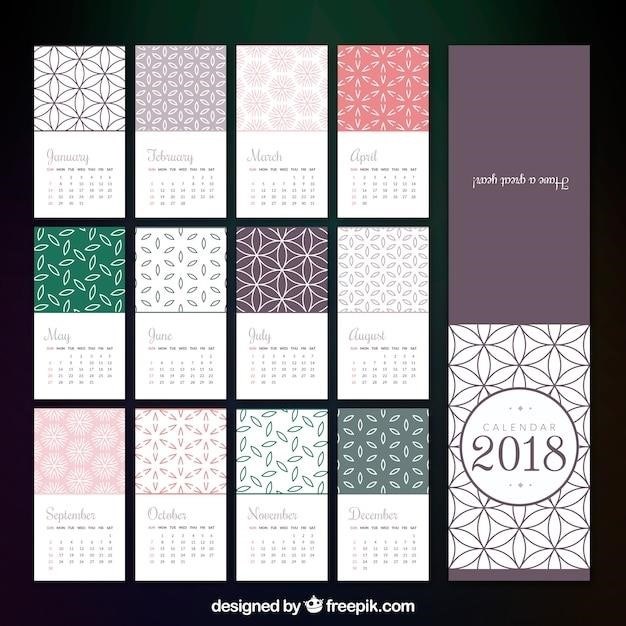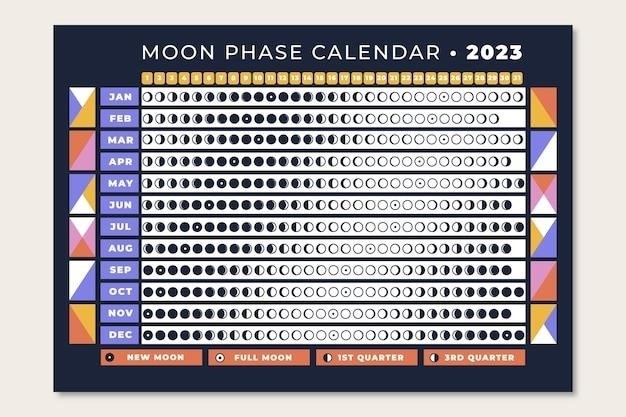A liturgical calendar is an essential tool for Catholics, providing a comprehensive overview of the liturgical year, including feast days, solemnities, and other significant events. These calendars offer a convenient way to stay organized and engaged with the Church’s liturgical rhythm. Many websites offer free printable liturgical calendars in PDF format, allowing you to customize and use them for personal or parish purposes. These calendars can be a valuable resource for individuals, families, and communities seeking to deepen their understanding and participation in the liturgical life of the Church.
What is a Liturgical Calendar?
A liturgical calendar is a structured guide that outlines the annual cycle of religious observances within a particular faith tradition. It provides a framework for understanding the liturgical year, which is a period of time marked by specific celebrations, commemorations, and readings. In the Catholic Church, the liturgical calendar is a vital tool for organizing the worship and spiritual life of the community. It helps to create a sense of continuity and rhythm throughout the year, highlighting the key events and themes of the Christian faith.
The liturgical calendar is divided into seasons, each with its own distinct character and focus. The seasons of Advent, Christmas, Lent, and Easter are the most prominent, but there are also periods of Ordinary Time, which provide a space for reflection and growth. The calendar also includes specific feast days, solemnities, and memorials dedicated to various saints and events in the history of the Church.
The liturgical calendar serves as a roadmap for the celebration of the Mass, the sacraments, and other liturgical practices. It helps to guide the selection of readings, hymns, and prayers, ensuring that the liturgy is appropriate to the specific season or occasion. By understanding the liturgical calendar, Catholics can deepen their appreciation for the richness and depth of the Church’s tradition, engaging more fully in the life of faith.
Why Use a Printable Liturgical Calendar?
Printable liturgical calendars offer a multitude of benefits for individuals and communities seeking to enhance their understanding and engagement with the liturgical year. They provide a readily accessible and visually appealing way to track important dates and celebrations, fostering a deeper connection with the rhythm of the Church’s life.
One of the primary advantages of using a printable liturgical calendar is its ability to facilitate planning and preparation for liturgical events. By having a visual overview of the liturgical year, individuals can anticipate upcoming feast days, solemnities, and seasons, allowing them to plan their prayer life, spiritual practices, and participation in liturgical celebrations accordingly.
Printable calendars also serve as valuable tools for fostering a sense of community and shared faith. By displaying a liturgical calendar in a home, parish, or other gathering space, individuals can be reminded of the Church’s ongoing life and the importance of participating in its celebrations. The calendar can serve as a catalyst for discussion and reflection, encouraging families, friends, and fellow parishioners to engage in meaningful conversations about faith and the liturgical year.
Key Features of Liturgical Calendars
Liturgical calendars are designed to provide a comprehensive and user-friendly guide to the Church’s liturgical year, incorporating essential features that enhance understanding and engagement with the liturgical rhythm. These features ensure that individuals and communities can easily navigate the calendar and access crucial information about specific dates and celebrations.
A key feature of liturgical calendars is the clear and concise presentation of liturgical seasons and their corresponding colors. Each season, such as Advent, Christmas, Lent, and Easter, is designated with a specific color, which visually represents the unique character and themes of that particular period. This color-coding system helps users readily identify the liturgical season and its associated themes, facilitating a deeper understanding of the Church’s cycle of prayer and celebration.
In addition to liturgical seasons, liturgical calendars typically include a detailed listing of feast days, solemnities, and memorials. These events are categorized according to their rank and importance within the liturgical year, providing users with a clear understanding of the significance of each celebration. The calendar may also include information about the readings for each Mass, the appropriate liturgical colors, and other relevant details, making it a comprehensive resource for liturgical planning and participation.
Finding Free Printable Liturgical Calendars
The accessibility of free printable liturgical calendars has significantly expanded in recent years, making it easier than ever for individuals and communities to access these valuable resources. A wide range of websites dedicated to liturgical resources offer free printable calendars, providing users with a variety of options to suit their specific needs and preferences.
One effective approach to finding free printable liturgical calendars is to conduct a simple online search using keywords such as “free printable liturgical calendar 2024 PDF” or “Catholic liturgical calendar 2024 download.” This search will yield numerous websites offering free printable calendars, including those specifically designed for the 2024 liturgical year.
Another valuable resource for finding free printable liturgical calendars is the websites of dioceses and parish communities. Many dioceses and parishes offer free printable calendars on their websites, providing a convenient way for members of the local Church to access liturgical information. These calendars often incorporate specific details relevant to the diocese or parish, making them particularly useful for local communities.
Types of Liturgical Calendars Available
The diversity of liturgical calendars available caters to a wide range of needs and preferences, ensuring that individuals and communities can find resources that align with their specific requirements. From comprehensive calendars encompassing the entire liturgical year to focused calendars highlighting specific seasons or events, there is a calendar for every purpose.
One common type of liturgical calendar is the full-year calendar, which provides a complete overview of the liturgical year, including feast days, solemnities, and other significant events. These calendars are particularly useful for individuals and communities seeking a comprehensive understanding of the liturgical rhythm.
Another type of liturgical calendar focuses on specific seasons or events within the liturgical year. For example, Advent calendars highlight the season of Advent, while Lenten calendars provide a detailed guide to the season of Lent. These focused calendars can be a valuable resource for individuals and communities seeking to deepen their understanding and engagement with specific seasons.

Additionally, liturgical calendars can vary in their level of detail. Some calendars provide a basic overview of liturgical events, while others offer more detailed information, including scripture readings, liturgical colors, and prayers. The level of detail often depends on the intended use of the calendar, with more comprehensive calendars suitable for individuals or communities seeking in-depth liturgical information.
Using the Liturgical Calendar for Planning
A liturgical calendar is not merely a static record of dates; it is a dynamic tool for planning and enriching the liturgical life of individuals, families, and communities. By utilizing a liturgical calendar, individuals can proactively engage with the liturgical year and incorporate its rhythms into their daily lives.
For individuals, a liturgical calendar can serve as a guide for personal prayer and reflection. By marking significant feast days and solemnities, individuals can intentionally dedicate time for prayer and contemplation, deepening their spiritual connection to the liturgical year. The calendar can also prompt individuals to reflect on the themes and messages associated with each season, fostering a deeper understanding of the Church’s liturgical cycle.
Families can also benefit from using a liturgical calendar to plan family activities and celebrations. By marking important feast days and solemnities, families can create meaningful traditions and experiences that reflect the liturgical seasons. This can include celebrating feast days with special meals, attending church services, or engaging in family prayer and reflection. The calendar can also serve as a reminder to incorporate liturgical themes into family discussions and activities, fostering a shared understanding of the Church’s liturgical rhythm.
In communities, liturgical calendars can be used to plan parish events and activities. By coordinating events with the liturgical calendar, parishes can ensure that their activities align with the Church’s liturgical seasons and themes. This can include organizing parish missions, retreats, or special services that resonate with the specific season. The calendar can also serve as a guide for planning educational programs, workshops, or other activities that deepen the community’s understanding of the liturgical year.
Benefits of Using a Liturgical Calendar
Incorporating a liturgical calendar into one’s life offers numerous benefits, enriching spiritual growth, fostering a deeper connection to the Church, and enriching the liturgical experience. The calendar serves as a tangible reminder of the Church’s liturgical rhythm, allowing individuals to actively participate in the unfolding mysteries of the faith.
One of the primary benefits of a liturgical calendar is its ability to enhance personal prayer and reflection. By marking significant feast days and solemnities, individuals can intentionally dedicate time for prayer and contemplation, deepening their spiritual connection to the liturgical year. This intentional focus on prayer and reflection fosters a more meaningful engagement with the liturgical cycle.
Furthermore, a liturgical calendar can promote a deeper understanding of the Church’s liturgical cycle. By marking the different seasons and their associated themes, individuals can gain a richer appreciation for the Church’s year-long journey of faith. This understanding allows individuals to connect the events and readings of each season to their own lives, fostering a more profound spiritual connection.
Liturgical calendars also offer a practical framework for planning and organizing one’s spiritual life. By marking important feast days and solemnities, individuals can schedule time for prayer, reflection, and participation in liturgical events. This allows individuals to actively participate in the Church’s liturgical life, rather than passively observing it.
Popular Liturgical Calendar Websites
Several websites offer free printable liturgical calendars for the year 2024, providing a valuable resource for individuals and parishes seeking to navigate the liturgical year. These websites cater to various denominations, offering calendars that reflect the unique liturgical practices and traditions of each faith community.
For Catholics, the United States Conference of Catholic Bishops website provides a comprehensive liturgical calendar for the Dioceses of the United States of America. This calendar serves as a primary resource for authors of liturgical aids and is based on the General Roman Calendar. It includes detailed information about each day’s celebration, rank, liturgical color, and citations for the Lectionary for Mass and the Psalter cycle for the Liturgy of the Hours. The website also offers a wealth of resources for liturgical planning and celebration.
The Liturgy Office of the Bishops Conference of England and Wales website provides a free printable liturgical calendar for the year 2024, designed for use with Breviaries and people’s Missals. This calendar is a valuable resource for those seeking to deepen their understanding and engagement with the liturgical year.
Other websites, such as Sola’s Liturgical Calendar website, offer comprehensive liturgical calendars for the year 2024, incorporating various denominations and traditions. These websites provide a variety of resources for liturgical planning and reflection, including free printable calendars, daily readings, and other devotional materials.
Tips for Printing and Using Your Liturgical Calendar
Once you’ve found a free printable liturgical calendar that suits your needs, it’s essential to print and use it effectively. Here are some helpful tips to maximize its value and ensure a smooth integration into your daily life or parish planning.
Firstly, consider the paper you choose for printing. A thicker cardstock or photo paper will make the calendar more durable and long-lasting, especially if you plan to hang it on a wall or use it frequently. Additionally, consider using a color printer for a visually appealing and vibrant calendar that enhances its aesthetic appeal.
Once printed, take time to personalize your calendar. You can highlight important feast days or events, write notes about specific intentions for prayer, or use stickers or markers to denote special occasions. This personalization will help make the calendar more meaningful and relevant to your individual needs or parish ministry.
Remember to place your calendar in a prominent location where you can easily refer to it. Whether you choose to hang it on a wall, place it on your desk, or incorporate it into a planner, ensure its accessibility for regular consultation. This will help you stay informed about the liturgical rhythm of the year and engage more deeply with its diverse celebrations and commemorations.
In conclusion, utilizing a free printable liturgical calendar for 2024 can significantly enrich your spiritual life and deepen your understanding of the Church’s liturgical year. These calendars provide a valuable roadmap for navigating the various feasts, solemnities, and other significant events throughout the year, fostering a more conscious and meaningful engagement with the Church’s liturgical rhythm.
By incorporating a liturgical calendar into your daily life or parish ministry, you can foster a sense of unity and connection with the wider Catholic community. The calendar serves as a constant reminder of the Church’s rich tradition, its ongoing celebrations, and the profound beauty of its liturgical cycle. Whether used for personal reflection, family prayer, or parish planning, these calendars are a practical and inspiring resource for navigating the liturgical year and deepening one’s faith journey.
As you embark on the liturgical year 2024, consider utilizing a free printable liturgical calendar as a valuable tool for spiritual growth and engagement with the Church’s rich tradition. May its use bring you closer to Christ and foster a deeper appreciation for the beauty and significance of the liturgical year.



Leave a Reply
You must be logged in to post a comment.